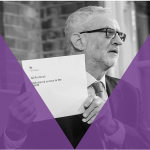
Prof Pete Dorey
Professor of British Politics in the School of Law and Politics at Cardiff University. In 2014, he was Visiting Professor of Politics at Bordeaux University. He has published over 100 books, articles and chapters on aspects of post-1945 British politics, many of these on political parties, leadership rhetoric and communication, and elections and voting patterns.
Email: dorey@cardiff.ac.uk

Section 4: Parties and the Campaign
- Something old, something new, something borrowed, something EU
- ‘Weak and wobbly’ to ‘get Brexit done’: 2019 and Conservative campaigns
- Conservative victories in Labour heartlands in the 2019 General Election
- More Blimp, less Gandhi: the Corbyn problem
- Corbyn and Johnson’s strategic narratives on the campaign trail
- The media and the manifestos: why 2019 wasn’t 2017 redux for the Labour party
- Down a slippery rope… is Britain joining the global trends towards right-wing populism?
- Farage: losing the battle to win the war
- Party election broadcasts… actually?
- GE 2019: lessons for political branding
- The postmodern election
As with UKIP in the previous three general elections, the intrigue generated by Nigel Farage’s Brexit Party was not about whether it would win any seats itself, but how it would impact upon the Conservative Party. With Boris Johnson having failed to fulfil his ‘do or die’ pledge to secure the UK’s exit from the EU on 31 October 2019, many Conservatives feared that the Brexit Party would attract support from erstwhile Conservative voters who felt betrayed by Johnson, and that the number of votes lost in the manner would, in some constituencies, deprive the Conservative candidate of victory.
Regardless of this risk, Johnson insisted that he was not willing do a deal with the Brexit Party, clearly confident that he would retain the support of the vast majority of pro-Brexit Conservative supporters. Part of Johnson’s confidence derived from his calculation that if the Brexit Party did deprive the Conservatives of a parliamentary majority on 12 December, this would make the UK’s exit from the EU more difficult or less likely; this scenario, he reasoned, would persuade sufficient numbers of putative Conservative voters to remain loyal, rather than be seduced by the blandishments of Farage.
Perhaps realising this, Farage announced, on 11 November, that the Brexit Party would not field candidates in the 317 seats won by the Conservatives in the 2017 election, nor would he himself stand as a candidate. This resulted in an immediate increase in Conservative support, due to erstwhile Brexit Party supporters now switching (back) to the Conservatives, with some polls recording a 19-point lead over Labour, although this lead fluctuated subsequently.
In announcing this withdrawal, Farage declared that the Brexit Party would instead field candidates in seats held by pro-Remain Labour and Liberal Democrat MPs. This, however, prompted anxiety that this too would jeopardise an outright victory for the Conservative Party, due to the potential for Leave voters in these seats to switch to the Brexit Party rather than the Conservatives. This was a particular concern for the Conservatives in some of their ‘target’ seats in the north of England, and the Midlands, where they had only narrowly been defeated in 2017. Would the Brexit Party’s candidature in these seats attract support from more would-be Conservative voters than Labour supporters?
On 12 December itself, the Conservatives won an emphatic victory overall, and in so doing, won many Labour seats in the North of England and the Midlands. However, it is difficult to discern the extent to which the Brexit Party impacted on the result in these constituencies. In several of these seats, as illustrated in Table 1, the tally of votes attracted by the Brexit Party candidate was more than the margin between the victorious Conservative candidate and the defeated Labour candidate. If the Brexit Party had not contested these seats, would their support have gone instead to the Conservative candidate, thus making their victory in these seats more emphatic, or would such support have remained with Labour, and thereby enabled the latter to retain at least a few more seats? In support of the latter interpretation is the sometimes-heard suggestion that some disillusioned life-long Labour Leavers in the North of England still could not bring themselves to vote Conservative, but were willing to vote for the Brexit Party. If this was the case, in at last some of these seats, the Brexit party did indeed damage Labour electorally, and facilitate the Conservatives’ victory.
However, the main reason for Labour’s defeat in these seats was a general surge in Conservative support since 2017, while Labour’s support was often only marginally down. In a few seats, the Brexit Party might have attracted just enough support from erstwhile Labour voters to deprive of the Party’s candidate of victory in 2019, but overall, Labour’s electoral woes in 2019 went far wider and deeper than the intervention of the Brexit Party: Boris Johnson’s charisma, the trust he inspired that he would “get Brexit done” (regardless of other concerns about his honesty), and the profound unpopularity of Jeremy Corbyn among working-class Labour supporters. In other words, even if the Brexit Party had not fielded any candidates in Labour marginals, the Labour Party would still have suffered a heavy and humiliating defeat overall.

